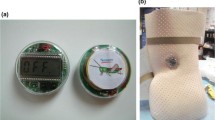Abstract
Purpose
Accurate evaluation of patient compliance with scoliosis brace usage has been a challenge for physicians treating patients with adolescent idiopathic scoliosis. This inability to accurately measure compliance has resulted in difficulty in determining brace treatment efficacy. This prospective study was performed to demonstrate the efficacy of using a new electronic brace compliance monitor, the Cricket.
Methods
The Cricket is a small encased circuit that can be attached to the brace and, by means of a temperature sensor, can record brace wear times. This study included ten subjects with adolescent idiopathic scoliosis who were prescribed the Wilmington scoliosis brace (thoraco-lumbo-sacral orthosis) into which the Cricket sensor was incorporated. Subjects kept a diary of brace wear times.
Results
Comparisons of data for the Cricket, subject diaries, and prescribed brace wear were evaluated. The mean error between the diary times and Cricket recording was 2%. Patient compliance was 78%.
Conclusions
The Cricket is a reliable, accurate, and sensitive device to determine patient compliance with scoliosis brace usage.


Similar content being viewed by others
References
Lonstein JE, Winter RB (1994) The Milwaukee brace for the treatment of adolescent idiopathic scoliosis. A review of one thousand and twenty patients. J Bone Joint Surg Am 76:1207–1221
Wiley JW, Thomson JD, Mitchell TM, Smith BG, Banta JV (2000) Effectiveness of the Boston brace in treatment of large curves in adolescent idiopathic scoliosis. Spine 25:2326–2332
Gurnham RB (1983) Adolescent compliance with spinal brace wear. Orthop Nurs 2:13–17
DiRaimondo CV, Green NE (1988) Brace-wear compliance in patients with adolescent idiopathic scoliosis. J Pediatr Orthop 8:143–146
Houghton GR, McInerney A, Tew A (1997) Brace compliance in adolescent idiopathic scoliosis. J Bone Joint Surg Br 69:852
Lou E, Raso JV, Hill DL, Durdle NG, Mahood JK, Moreau MJ (2002) The daily force pattern of spinal orthoses in subjects with adolescent idiopathic scoliosis. Prosthet Orthot Int 26:58–63
Havey R, Gavin T, Patwardhan A, Pawelczak S, Ibrahim K, Andersson GBJ, Lavender S (2002) A reliable and accurate method for measuring orthosis wearing time. Spine 27:211–214
Lavelle JR, Smith K, Platts R, Morley TR, Ransford AO, Edgar MA (1996) An assessment of brace compliance in adolescent idiopathic scoliosis using a new brace timer. J Bone Joint Surg Br 78:162
Dolan LA, Sabesan VJ, Shurr DG, Weinstein SL (2004) Reliability and validity of electronic temperature reading as proxy for TLSO wear time. In: Proceedings of the Association of Children’s Prosthetics–Orthotics Clinics (ACPOC) Annual Meeting, Banff, Alberta, Canada, March 2004
Katz DE, Browne RH (2005) The influence of how much a scoliosis orthosis is worn and its ability to prevent curve progression in adolescent idiopathic scoliosis. In: Proceedings of the Association of Children’s Prosthetics–Orthotics Clinics (ACPOC) Annual Meeting, Orlando, Florida, March 2005
Nicholson GP, Ferguson-Pell MW, Smith K, Edgar M, Morley T (2003) The objective measurement of spinal orthosis use for the treatment of adolescent idiopathic scoliosis. Spine 28:2243–2251
Helfenstein A, Lankes M, Ohlert K, Varoga D, Hahne HJ, Ulrich HW, Hassenpflug J (2006) The objective determination of compliance in treatment of adolescent idiopathic scoliosis with spinal orthoses. Spine 31:339–344
Takemitsu M, Bowen JR, Rahman T, Glutting JJ, Scott CB (2004) Compliance monitoring of brace treatment for patients with idiopathic scoliosis. Spine 29:2070–2074
Rahman T, Bowen JR, Takemitsu M, Scott C (2005) The association between brace compliance and outcome for patients with idiopathic scoliosis. J Pediatr Orthop 25:420–422
Bassett GS, Bunnell WP, MacEwen GD (1986) Treatment of idiopathic scoliosis with the Wilmington brace. Results in patients with a twenty to thirty-nine-degree curve. J Bone Joint Surg Am 68:602–605
Winter RB, Lonstein JE, Drogt J, Noren CA (1986) The effectiveness of bracing in the nonoperative treatment of idiopathic scoliosis. Spine 11:790–791
Emans JB, Kaelin A, Bancel P, Hall JE, Miller ME (1986) The Boston bracing system for idiopathic scoliosis. Follow-up results in 295 patients. Spine 11:792–801
Nachemson AL, Peterson LE (1995) Effectiveness of treatment with a brace in girls who have adolescent idiopathic scoliosis. A prospective, controlled study based on data from the Brace Study of the Scoliosis Research Society. J Bone Joint Surg Am 77:815–822
Peterson LE, Nachemson AL (1995) Prediction of progression of the curve in girls who have adolescent idiopathic scoliosis of moderate severity. Logistic regression analysis based on data from The Brace Study of the Scoliosis Research Society. J Bone Joint Surg Am 77:823–827
Rowe DE, Bernstein SM, Riddick MF, Adler F, Emans JB, Gardner-Bonneau D (1997) A meta-analysis of the efficacy of non-operative treatments for idiopathic scoliosis. J Bone Joint Surg Am 79:664–674
Acknowledgments
We would like to thank Lawall Prosthetics and Orthotics for integrating the sensors into the braces and Creative Micro Designs for manufacturing and providing the Cricket sensors.
Author information
Authors and Affiliations
Corresponding author
About this article
Cite this article
Rahman, T., Borkhuu, B., Littleton, A.G. et al. Electronic monitoring of scoliosis brace wear compliance. J Child Orthop 4, 343–347 (2010). https://doi.org/10.1007/s11832-010-0266-6
Received:
Accepted:
Published:
Issue Date:
DOI: https://doi.org/10.1007/s11832-010-0266-6




